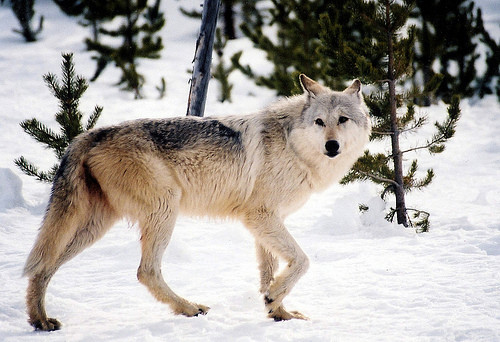How Do You Put A Species On The Endangered List - And When Do You Take It Off?

The Endangered Species Act turns 40 years old later this year, which is as good an anniversary as any to evaluate the state of one of the most landmark environmental laws in U.S. history. But how does a species make the cut to earn federal protections?
Putting an animal or plant on the endangered species list begins either with the U.S. Fish and Wildlife Service or the National Marine Fisheries Services deciding the creature is threatened or endangered or with a petition from an outside group. Once a species is listed, USFWS and NMFS can designate certain areas that it lives in as a protected habitat zone, and the agency compiles a recovery plan aimed at increasing the species’ numbers. There's no hard or fast rule as to what makes a species endangered or threatened.
Removing an animal or plant from the endangered species list is a case-by-case decision on the part of the USFWS or the NMFS. Agencies have to weigh the stability of the species’ population and its habitat. Some animals or plants may be “downlisted,” that is, moved from “endangered” to “threatened.” Once the agency publishes a proposal to delist or downlist in the Federal Register, it takes comments from the public, scientists and federal and state agencies, then makes the final call.
Delisting a species, especially a charismatic one like the bald eagle or the gray wolf, is a process fraught with political and public tension.
Gray wolves have bounced back considerably since being reintroduced to the lower 48 states in 1995. As of this past February, there are around 6,200 gray wolves in the U.S. outside of Alaska. The success has cheered environmentalists but also prompted ranchers and hunters to call for the government to remove protections against hunting the wolves.
It appears as though they’ll get their wish. Last week, the Los Angeles Times got ahold of a draft rule being prepared by the U.S. Fish and Wildlife Service that would completely remove endangered species protections for all gray wolves in the lower 48 states. Some scientists and officials see the move as the capstone on a successful recovery; some activists say the move comes too soon.
Certain groups of wolves in the U.S., called distinct population segments, or DPS, have already been delisted: the Western Great Lakes population in 2009, most of the Northern Rocky Mountain population in 2011 and populations in Minnesota and Wyoming in 2012. But if the new rule passes, smaller populations of wolves in the Pacific Northwest would rest with state authorities.
The rule will likely appear in the federal register in the coming months. USFWS isn’t yet commenting specifically on the draft rule obtained by the L.A. Times.
"As demonstrated by our recent release of scientific monitoring results for 2012, the populations of gray wolves in the Northern Rocky Mountains and the Western Great Lakes continue to be robust, reflecting a recovery that is one of the world's great conservation successes,” the USFWS said in an emailed statement.
The draft rule would not apply to gray wolves in Alaska, which are not currently protected under the ESA, or a small population of 75 Mexican wolves in Arizona and New Mexico, which would remain under protection.
Delisting is rare but not unheard of. Bald eagles, one of the first species to receive protection under the ESA, were removed from the list in 2007. These birds had dwindled to 417 pairs in 1963 but by 2007 had recovered to a healthy 11,000 pairs. In 2013, USFWS has added two species to the list so far, both plants: Umtanum Desert Buckwheat and White Bluffs Bladderpod, both of which are designated as threatened. In March, the Viginia northern flying squirrel was deemed recovered and delisted -- with somewhat less controversy than the storm brewing over the wolf.
Some ecologists are frustrated by the appearance that the popularity of a species seems to hold the most weight in delisting discussions.
“Every year, populations of plants, insects and even microbes reach the brink of extinction, virtually unnoticed,” University of California Santa Barbara ecologist Leah Gerber and NMFS biologist Douglas P. DeMaster told ABC News. “In the meantime, the threat of large-mammal extinctions arouses public passions, attention and, ultimately, money. It is here, at the intersection of sentimentality and scientific controversy, that conservation biologists typically face their greatest challenge.”
© Copyright IBTimes 2024. All rights reserved.





















